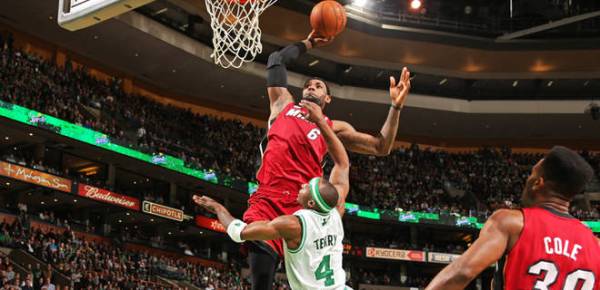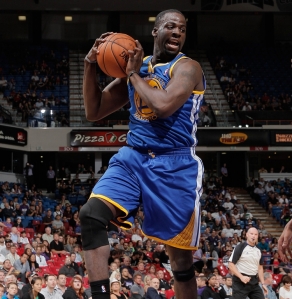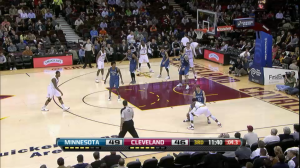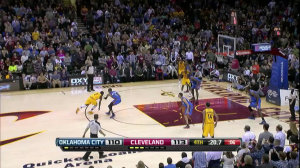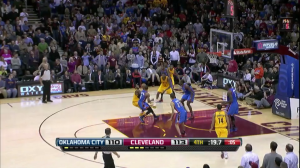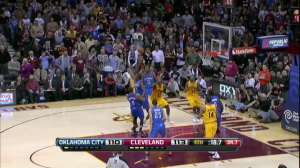The Meaning of Every NBA Game on Wednesday Night
April 16, 2013 2 Comments

Credit: SBNation.com
The final day of the NBA regular season is tomorrow, and with playoff seeding in the Western Conference and lottery seeding still up in the air, nearly every game has some impact on the future of the NBA. I ranked the games in order of importance. That is: games that really impact nothing will be ranked lower, even if they might contain some of the more entertaining basketball of the night. Games that mean more will be ranked higher, even if two of the three worst teams in the NBA are involved.
Without further ado, I’ll start with the leading team in the West:
15. OKC @ MIL
Simply put – this game impacts nothing at all directly. It might be entertaining, but ultimately meaningless in seeding for draft or playoffs, which is unlike every other game.
Oklahoma City clinched the top seed in the Western Conference. They cannot surpass Miami for home court. Expect them to take it easy. Their first round opponent can be any of Houston/LA Lakers/Utah depending on the results of other games. Aside from that, the other game that they might care about is the Celtics-Raptors game, as Toronto owes Oklahoma City a reverse-protected draft pick. If Toronto wins their final two games, the pick could end up as low as 12. Kevin Durant is also technically in the race for the scoring title, but would need to score 70 to surpass a resting Carmelo Anthony.
Milwaukee has lost 10 straight and probably wants to get a win before facing the Miami buzz saw. Otherwise, they can’t move up or down, and their draft position is locked.
14. PHI @ IND
The Sixers have too much pride to play for ping-pong balls, but that’s the only significant purpose this game serves for them. The team can end up with as high as the 10th best lottery odds outright with a loss, combined with at least one win each from Toronto and Portland in the next 2 days. If they win, they could end up as low as 12 outright. This will be Doug Collins’s final game as head coach of the team.
Indiana has clinched the 3-seed and will play either Chicago or Atlanta in the first round. While they have nothing to play for, because of the Boston Marathon Attacks they will not be playing on a back-to-back or even for a few days, so they may play their starters for at least a decent chunk of time.
13. BOS @ TOR
Boston is confirmed for the 7-seed and their draft position at 16. They’ll likely spend the game resting their players and preparing for a grueling series with the Knicks, or at least they think they will.
Toronto has nothing to play for but a win in their final two games. While they technically have a chance at a top-3 seed, they most likely will end up giving this pick to the Thunder, to whom they owe a reverse-protected pick. With wins in their final two games, the Thunder will end up with a first rounder with lottery odds in the 10-12 range.
12. MIN @ SA
Minnesota might be playing the lottery. Currently with the 9th best odds for the number one overall pick, they could conceivably end up in a tie for 7th with Washington and Detroit if both of those teams win. It might be better for them to lose, however winning will not send them lower than 9th. Which is good, since this year has done enough damage to the franchise’s future.
San Antonio clinched the 2-seed in the West and the third best record overall. They don’t have a draft pick owed to them, so they likely will sit Duncan/Parker again. They could face any of Golden State/Houston/LA Lakers in the first round, but the opponent will be determined by results of other games. Expect them not to go all-out for a win.
11. NOH @ DAL
New Orleans probably will play lottery odds. NOH can end up moving up or down in the draft (between 4 and 6) depending on other results, though more than likely they’ll end up where they are, 5th.
Dallas is locked into the 13th best lottery odds and has no chance at the playoffs. As pointed out to me by @pucktacular on Twitter, they will be playing to finish .500. About all I can say about them.
10. DET @ BKN
Detroit is in the mix for lottery odds as high as 6th, if Sacramento wins and they lose. Currently they sit tied for 7th best with Washington. If they win, they could end up as low as 9th. Regardless, they are only playing for draft position, though there’s a big range. A loss is the best case, but that might not happen with Lawrence Frank and Joe Dumars looking to save their jobs and an opponent who might also not be looking to win. They’ve played better as of late.
Brooklyn is guaranteed to finish as the 4-seed. They will likely rest at least some players and watch to see who they’ll play in round one.
9. WAS @ CHI
Washington, like Detroit, can finish with lottery odds as good as 6th and as bad as 9th. Currently, they sit tied for 7th best. A loss is the best case; while the Wizards played better in the second half, they’ve been in a rut since Brad Beal was lost to injury.
Chicago can clinch the 5-seed in the East with a win in this game plus an Atlanta loss in either of their final two games. If Chicago loses this game, they can still end up as the 5-seed if Atlanta loses both of their remaining games. If they end up 5th, Chicago will play Brooklyn. If they end up 6th, Chicago will play Indiana.
8. ATL @ NYK
Atlanta, if they win on Tuesday against Toronto, can clinch the 5 seed with a win. That would secure a Brooklyn-Atlanta first round series, also known as the NBA TV invitational. A loss in either game could open the door for Chicago, which owns the head-to-head tie-breaker with Atlanta based off winning the regular season series 2-1, to take the 5-seed if they win their final game. If Atlanta loses both, they will end up as the 6-seed regardless of what Chicago does and play Indiana.
The Knicks have clinched the 2-seed and will play Boston in round one. They’ve suffered so many injuries that they likely will sit out most of their best players Wednesday, including Carmelo Anthony, who will win the scoring title provided that Kevin Durant scores under 70 points the same night.
7. GS @ POR
Portland might be playing the lottery. Depending on the result of their game against the Clippers on Tuesday, POR could possibly end up with a pick as high as 10 in the upcoming draft. They’ll need to lose both and have Toronto win to make this possible. Philadelphia winning would also help their cause. They have ensured they keep their first round pick, which is top 12-protected.
Golden State clinches the 6-seed in the West with a win or a loss combined with a Houston loss. With a loss and a Houston win, they end up 7th. Expect them to play hard to avoid San Antonio and OKC in the first round. Stephen Curry has the three point field goal record in sight, needing only 2 to have made the most in a season in league history. Golden State owes a first rounder to Utah, which may get better or worse with the result of this game.
6. PHX @ DEN
Phoenix has a lot of stuff going on. First, if they win they are guaranteed the 4th best lottery odds. If they lose, they could end up with the T-3rd best odds if Cleveland beats Charlotte. They have sat starters or played them limited minutes in games where it has been advantageous for them to lose for draft position. Expect the same here. Second, they will obtain the LA Lakers first round pick with a LAL loss and a UTA win. They could end up with two lottery picks, including one with top 3 odds, if everything goes right. Big day for them.
Denver has clinched home court but not their seed. They can clinch a top 3 seed in the West with a win or an LA Clippers loss in their final 2 games. Their opponent as the 3-seed can be either Golden State or Houston depending on the results of other games. If they lose and LAC wins out, DEN ends up 4th. If they finish 3rd, Golden State or Houston will be their opponent. If they finish 4th, Memphis will be the opponent. Expect them to play hard enough to win, which won’t be difficult for them at home against a setting Suns team. (I’m sorry for the pun)
5. ORL @ MIA
Orlando should be, and probably will be, playing the lottery. A loss for Orlando will guarantee at least a share of the odds at having the best chance at the #1 overall pick. While they’ve played Miami well, I imagine they are going to roll over to try and ensure those odds for this game. There’s too much to lose by not doing that.
Miami has clinched home court throughout the playoffs already and is just fine-tuning.
4. CLE @ CHA
Both teams will be playing for ping-pong balls which should make this a very, very interesting game (but from afar only). Cleveland currently has the third best lottery odds and has been playing the lottery for a month straight. Don’t be surprised if Kyrie Irving or other players sit out. This reportedly may be the end of the road for Byron Scott as Cavs coach.
Charlotte should be playing the lottery. Charlotte currently is tied with Orlando for the best lottery odds. A loss will ensure that they have a share of the best lottery odds. While they’ve been better to watch as of late, this team needs help and should probably try to lose. But can they out-lose Cleveland?
3. LAC @ SAC
The Clippers need to win their final 2 games and hope that Denver loses their final game in order to get the third seed. They can guarantee home court by having a record at least equal to Memphis’s. Winning both ensures home court. If Memphis loses their final game, LAC would only have to win one game. They cannot drop below 4 via being a division champion, and because they won the Pacific Division if they have the same record as their first round opponent they will have home court advantage.
Sacramento could possibly (but at this point, we really don’t know, and GOD I hope this isn’t the case) be hosting its final NBA game with this specific franchise. That should be motivation enough to go for a win. Lottery odds are inconsequential, though with a win they could potentially move back 2 spots in the draft to 8th by virtue of a tie with Detroit and Washington (if they each lose). A loss, combined with a win from NOH, could give them a share of the 5th best lottery odds. Again, I imagine the priority from the players is to win here.
2. UTA @ MEM
Utah has to win this game to make the playoffs. They also need help from Houston, who they’ll need to beat the Lakers. Losing will result in the 14th draft pick and no playoff appearance.
Memphis is in an interesting spot. They are guaranteed the 5-seed, but depending on the result of the LAC/POR game on Tuesday they will either (a) know they can clinch home court advantage with a win, or (b) have the chance to earn home court with a win. Either way, because the Clippers play at 10:30 (that is, after the Grizzlies play), the Grizzlies will have to play to win if they want at least a shot at home court.
1. HOU @ LAL
This game has by far the most wide-reaching implications. To make things easier, bullet points!
- Roughly half the league has a rooting interest in the game, so it’s got that going for it.
- Houston clinched a playoff spot and can end up as the 6-, 7-, or 8-seed in the West. With a win, they can end up at 6 (with a GS loss) or 7(with a GS win). They likely want to avoid the Thunder, so they’ll play to win. If they lose, they end up in the 8-seed.
- LA Lakers can end up as the 7-, 8-, or 9-seed and out of the playoffs entirely. If they win, they will finish 7th and play SA in the first round. If they lose, they finish 8th (if Utah loses in Memphis) or 9th (if Utah wins).
- #WinItForKobe
- The UTA-MEM game occurs before this one, so LAL will know whether or not this is a must-win game. However, avoiding the Thunder is optimal, so no matter what they will play to win.
- If LAL makes the playoffs – Cleveland receives LAL’s first round pick – the pick would be swapped with Miami’s first rounder, which then goes to Phoenix.
- If LAL misses the playoffs – Phoenix receives LAL’s first round pick – they have the pick no matter what so long as LAL is in the lottery. The Cavs would still have the Miami Heat pick. This pick is more protected than the vice president in an undisclosed location.
The NBA has a lot on the line this week – be sure not to miss it!
